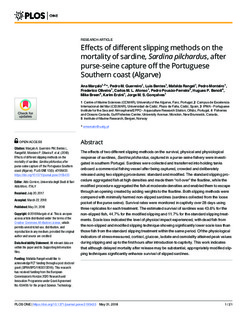Effects of different slipping methods on the mortality of sardine, sardina pilchardus, after purse-seine capture off the Portuguese southern coast (Algarve)
| dc.contributor.author | Marcalo, Ana | |
| dc.contributor.author | Guerreiro, Pedro | |
| dc.contributor.author | Bentes, Luis | |
| dc.contributor.author | Rangel, Mafalda | |
| dc.contributor.author | Monteiro, Pedro | |
| dc.contributor.author | Oliveira, Frederico | |
| dc.contributor.author | Afonso, Carlos | |
| dc.contributor.author | Pousao-Ferreira, Pedro | |
| dc.contributor.author | Benoit, Hugues P. | |
| dc.contributor.author | Breen, Michael | |
| dc.contributor.author | Erzini, Karim | |
| dc.contributor.author | Goncalves, Jorge M.S. | |
| dc.date.accessioned | 2018-09-20T12:39:47Z | |
| dc.date.available | 2018-09-20T12:39:47Z | |
| dc.date.created | 2018-09-05T11:28:16Z | |
| dc.date.issued | 2018 | |
| dc.identifier.issn | 1932-6203 | |
| dc.identifier.uri | http://hdl.handle.net/11250/2563691 | |
| dc.description.abstract | The effects of two different slipping methods on the survival, physical and physiological response of sardines, Sardina pilchardus, captured in a purse-seine fishery were investigated in southern Portugal. Sardines were collected and transferred into holding tanks onboard a commercial fishing vessel after being captured, crowded and deliberately released using two slipping procedures: standard and modified. The standard slipping procedure aggregated fish at high densities and made them “roll over” the floatline, while the modified procedure aggregated the fish at moderate densities and enabled them to escape through an opening created by adding weights to the floatline. Both slipping methods were compared with minimally harmed non-slipped sardines (sardines collected from the loose pocket of the purse seine). Survival rates were monitored in captivity over 28 days using three replicates for each treatment. The estimated survival of sardines was 43.6% for the non-slipped fish, 44.7% for the modified slipping and 11.7% for the standard slipping treatments. Scale loss indicated the level of physical impact experienced, with dead fish from the non-slipped and modified slipping technique showing significantly lower scale loss than those fish from the standard slipping treatment within the same period. Of the physiological indicators of stress measured, cortisol, glucose, lactate and osmolality attained peak values during slipping and up to the first hours after introduction to captivity. This work indicates that although delayed mortality after release may be substantial, appropriately modified slipping techniques significantly enhance survival of slipped sardines. | nb_NO |
| dc.language.iso | eng | nb_NO |
| dc.title | Effects of different slipping methods on the mortality of sardine, sardina pilchardus, after purse-seine capture off the Portuguese southern coast (Algarve) | nb_NO |
| dc.title.alternative | Effects of different slipping methods on the mortality of sardine, sardina pilchardus, after purse-seine capture off the Portuguese southern coast (Algarve) | nb_NO |
| dc.type | Journal article | nb_NO |
| dc.type | Peer reviewed | nb_NO |
| dc.description.version | publishedVersion | nb_NO |
| dc.source.volume | 13 | nb_NO |
| dc.source.journal | PLoS ONE | nb_NO |
| dc.source.issue | 5 | nb_NO |
| dc.identifier.doi | 10.1371/journal.pone.0195433 | |
| dc.identifier.cristin | 1606845 | |
| cristin.unitcode | 7431,15,0,0 | |
| cristin.unitname | Fangst | |
| cristin.ispublished | true | |
| cristin.fulltext | original | |
| cristin.qualitycode | 1 |
Tilhørende fil(er)
Denne innførselen finnes i følgende samling(er)
-
Articles [3012]
-
Publikasjoner fra CRIStin [3070]
